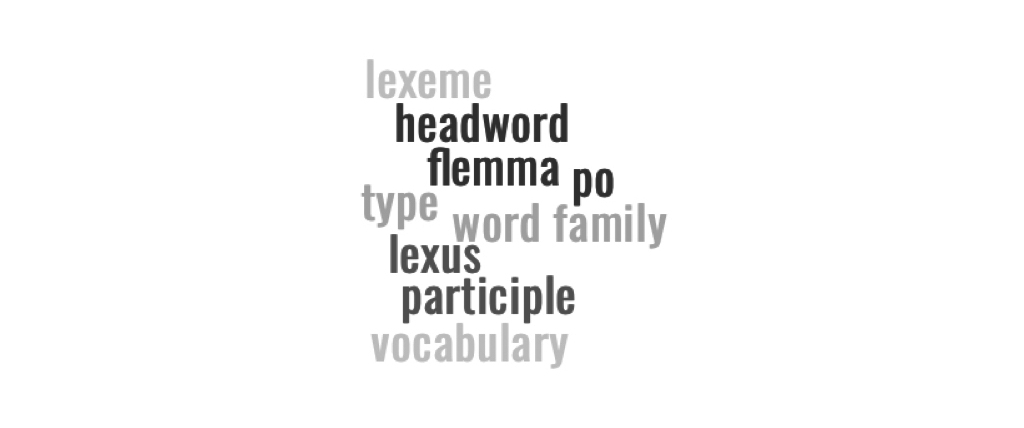
Over recent years, the field of second language vocabulary research has advanced in many ways. And these advancements have driven a need for a more specialized vocabulary, to define words in different ways. Specialized linguistic terms are used to draw important distinctions. And many of these distinctions are likely quite useful for language teachers.
Tokens
Sometimes referred to as the running words in a text, tokens are perhaps the simplest way to look at vocabulary. This refers to the actual number of words on the page or in the listening passage. In class, it is the number of tokens that we count if we are trying to measure reading speed. This is typically represented as the number of tokens read divided by the number of minutes it took to read them. When we ask students to write a 1,000-word essay we are asking for 1,000 tokens.
Types
Types refers to the number of different words in the passage. For example, in the sentence – The quick brown fox jumps over the lazy dog. – there are nine tokens, but only eight types of word (since the appears twice). Types provides us with a very basic measure of how many words a student needs to know to fully understand the sentence or passage.
Lemmas
Lemmas are words that share the same root form and belong to the same part of speech. For example, if we are talking about a lemma for the verb EAT (usually we capitalize the name of the lemma), we would include all forms of that verb (i.e., eat, eats, eating, ate, and eaten). For nouns, the dictionary form of the word (e.g., book) and its plural (books) would be counted together as a single lemma. Adjective lemmas include the base form (e.g., happy) along with their comparative and superlative forms (happier and happiest).
When we talk about how many lemmas our students know, we assume that they recognize the connection between simple base forms and their related inflections. In other words, if a story included hungry, hungrier, and hungriest, and we believe our learners are able to infer the meanings of –er and –est forms from their knowledge of the base form and its suffixes, we might count these as a single lemma. If we don’t think they have the grammatical knowledge to make that leap, we are better off treating them as three different tokens.
Headwords
Lemmas are closely related to the concept of headwords. Headwords are how lexicographers refer to dictionary entries. A dictionary that boasts 50,000 headwords has 50,000 entries. An entry is a lot like a lemma in that we can find an entry for eat, but are less likely to find eats and eating listed separately.
Publishers of language learning materials, in particular, graded readers, regularly adopt headwords as a means of assessing the difficulty of their books. Books that include a higher number of headwords are considered to be at a higher level than those with fewer headwords as they demand broader vocabulary knowledge from language learners.
Word families
The concept of word families has been widely adopted in applied linguistics. Indeed, word families are the basis of the well-known Academic Word List (AWL) that many university teachers wish their students to know. The AWL is a good starting point for instructors as it has reduced academic vocabulary to a learnable list of 570 word families. But what exactly is a word family?
‘Word family’ usually refers to a base word and all of its derived forms, regardless of their parts of speech. For example, if we are examining the word family for employ, we would include the other verb forms (employs, employing, employed) just as we would for the EMPLOY lemma. However, we would also include adjectives like employable, and nouns like employment, employer, and employee.
In fact, there are seven levels of word family membership. These range from very small categories (a Level 1 family includes only the individual token; Level 2 includes lemma forms), to much larger Level 6 families like I have described above for employ. Level 7 families include classical affixes and roots that are sometimes arcane even to native English speakers.
You can see, then, that simply asking your students to “learn the AWL” is far more involved than merely memorizing the meanings of 570 words. A learnable list of 570 families’ headwords can easily become an unmanageable list of thousands of derivative forms. Language instructors are well advised to draw attention to prefixes and suffixes that will help reduce students’ learning load. Likewise, learners can be reminded of the basic meanings of word stems. Students of economics may know what unemployment is, but fail to recognize its relation to employ, or even know what employ means.
Flemmas
As you might guess, a flemma lies somewhere between a lemma and a word family (from which it gets its f). Flemmas are groups of words that include lemma forms, but make no distinction between parts of speech. So, the lemma for the noun HAND includes hand and the plural, hands. The lemma for the verb HAND (as in hand me the stapler) includes handing, handed, and others. All of these are included in the flemma for HAND.
Flemma is a good word to know when you consider that many lemma-based word lists are actually flemma-based lists. You are unlikely to see a word list that contains hand twice.
This list of terms provides a good starting point for those teachers wading through the now burgeoning body of second language vocabulary research. And it also helps focus our thinking on how to best teach vocabulary to our students.
Comments(0)
Leave a message here